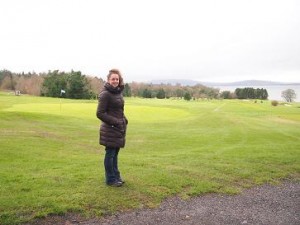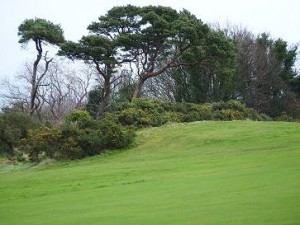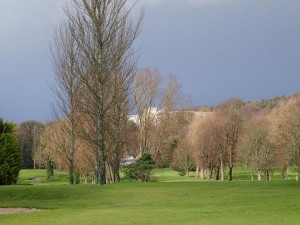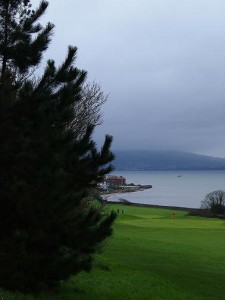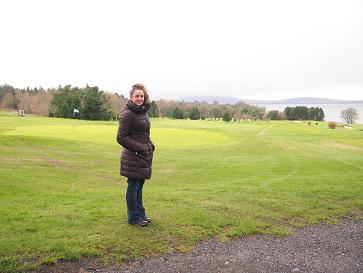
Hi all, four months have flown by since I started my apprenticeship so I thought I would give you all a little update on how it has been going.
I firstly had to get an idea of roughly how many golf courses there are in Northern Ireland, their distribution and how long they have been established. This is where I really got my eyes opened to the potential scale of this project as there are approximately 102 well established, fully functioning golf courses in Northern Ireland. Co. Antrim supports nearly 40 of these courses followed closely by Co. Down which has around 34 courses. I had no idea there were so many courses spread throughout our six counties in the North and when you think about it that is a lot of habitat but more importantly a lot of habitat we know relatively little about in terms of biodiversity.
Having found out how many courses there were, I now needed to know what sort of habitat was on them. Uniformly all the courses are made up of fairways, tees, greens and a rough margin which is boarded by the out of bounds area. It is these boundaries of rough that I am most interested in as, in most cases, they are little pockets of wilderness left to do their own thing. But what type of wilderness was another important question as the courses are all made up of different habitat, largely influenced by their location and the history of the site in which they were developed. I found that the majority of courses in Northern Ireland are either links courses or parkland with the odd moorland/meadowland course.
Links courses are built along the seaside with numerous sandy bunkers and sandy soil which is free draining. The rough little pockets of wilderness on these courses would be natural seaside grasses such as Ammophila arenaria (marram grass). The most famous links course in Northern Ireland is Royal Portrush which hosted the 2012 Irish Open last summer. The majority of golf courses in Northern Ireland tend to be parkland courses which are usually linked historically with an old estate for example the Clandeboye and Blackwood golf courses in Co. Down. On the parkland courses the rough areas tend to be areas of woodland which are mature and sometimes linking back to ancient woodland or newly planted stands that are just starting to get established on the course.
Having considered the types of courses in Northern Ireland, their location and the amount of time and resources I have for my apprenticeship I decided that I would study 7 courses that have parkland as their main habitat. This would allow me to develop sampling techniques that I could carry out across all the sites and would then allow me to make comparisons between the sites. My choice of site was mainly influenced by age and location as I wanted to get sites that were well established but in areas that may have ancient woodland either on or beside the course as I would like to make comparisons between the different age stands of trees on the course.
The courses that are part of my study and will be surveyed this year are; Belvoir, Blackwood, Kilrea, Knock, Lough Erne, Moyola and Royal Belfast. All the golf clubs have been so helpful and willing to give me access to the courses and I am so grateful because without them on board this project would not be able to go ahead.
I would like to give a big thank you to the green keepers and managers who have given me guided tours of their golf courses. Their guidance and knowledge of the courses has really helped me to develop my study and chose my trap locations.
With the study sites secured I then had to plan exactly what species I was going to focus on and how. To enable me to do this I have had some great mentoring sessions from firstly Dr Damian McFerran who is the record centre manager here at CEDaR and my line manager. Damian has introduced me to beetle identification and has been teaching and guiding me through identifying spiders. Dr Roy Anderson, who is an Environmental Consultant, has been teaching me about pitfall trapping, how to make my own flight traps and he has verified my beetle records and given me one to one sessions on beetle identification. Mr Edward Rolston, who is an expert moth recorder, has accompanied me on a visit to Belvoir golf course to pick out the best locations for placing moth traps; he has been teaching me about the different type of traps and how to use them. I have also received help and guidance from Mr John McClean who is the Northern Ireland Micro-Lepidoptera Recorder. John accompanied me to Blackwood golf course where he walked the site with me looking for the best location for setting a moth trap and explaining why. He also talked me through the different type of moths that can be trapped at different times of the year.
I am only going to trap in the areas of rough and out of bounds on the golf course as this is the habitat that is least managed and in some cases not managed. I think these areas could be real havens for biodiversity and hopefully the species I trap will confirm or dispel this theory. Another benefit of only studying the areas of rough on the golf courses is that I can set my traps and leave them to collect data over a period of time and they will not be interrupting play on the course. I will be setting pitfall traps to look at the ground beetles and spiders and I will also be setting flight traps to look at flying beetles. I intend to set a series of moth traps at each site at least once a month to get a good idea of the different species of moths that are utilizing the sites.
I hope to start my field work at the start of April so the next few weeks are going to be spent making traps and visiting the sites again to choose suitable locations for them. Whilst doing this I will also continue to develop my identification skills. I am really enjoying my apprenticeship – the research is really interesting and at times challenging but most importantly I feel it is because all the staff here at CEDaR have made me feel very welcome and part of the team.
That is all for now, I will keep you posted when the field work starts
Rachel

